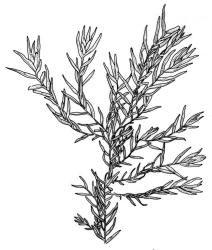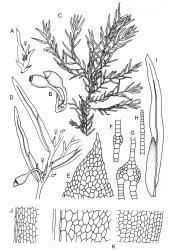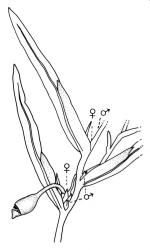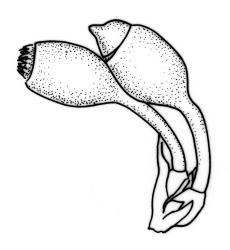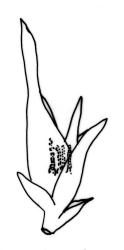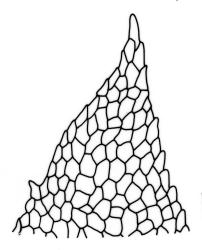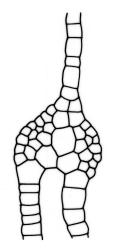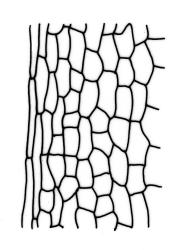- ≡ Conomitrium berteroi Mont., Ann. Sci. Nat., Bot. sér. 2, 8: 250 (1837) – as berterii
- = Conomitrium dillenii Mont., Ann. Sci. Nat., Bot. sér. 2, 8: 250 (1837) nom. illeg.
- = Conomitrium muelleri Hampe, Linnaea 28: 214 (1856)
- ≡ Octodiceras muelleri (Hampe) A.Jaeger, Ber. Thätigk. St. Gallischen Naturwiss. Ges. 1874–75: 135 (1876)
- ≡ Fissidens muelleri (Hampe) Mitt., Trans. & Proc. Roy. Soc. Victoria 19: 91 (1882)
Fissidens fontanus sensu Scott & Stone (1976) non F. fontanus (Bach.Pyl.) Steud.
Plants to 100 mm, yellow-green to dark green, soft, flexuous, aquatic, in tufts or mats. Stems frequently branched, with rhizoids at stem base, in leaf axils, or rarely subtending plantlets near leaf apex. Leaves in many pairs, distant, patent, flaccid when moist, irregularly distorted when dry, linear-lanceolate, 5.0–9.0 × 0.5–0.9 mm; apex acuminate; laminae unistratose; vaginant laminae ⅖–½ leaf length, almost closed; dorsal lamina often failing above leaf insertion, tapered to its base; margins of apical, dorsal, and vaginant laminae entire with occasional serrations, especially near the leaf apex; marginal cells occasionally distinct in a few rows on the proximal third of the vaginant laminae, narrower and longer, forming a weak unistratose border; cells of apical and dorsal laminae quadrate to hexagonal, smooth, non-bulging, with thin walls, (10–)15–18(–22) × (10–)15–18(–22) µm. Costa indistinct, failing 15–40 cells below leaf apex, modified bryoides-type in cross-section.
Paroicous. Perichaetia terminal on short shoots, which may be deciduous at capsule maturity; leaves greatly reduced. Perigonia terminal on short shoots. Setae green to yellow, stout, fleshy, 0.8–1.5 mm; capsules erect to horizontal, symmetric, 0.7–1.0 mm; exothecial cells in c. 80 columns; operculum bluntly apiculate from a conic base, c. ⅓ the length of theca. Peristome modified bryoides-type; teeth 50–75 µm wide at base, irregularly divided, scarcely covering capsule mouth; abaxial trabeculae in the undivided region of the tooth higher than lamellar ornamentation, abaxial lamellae papillose, the papillae ± in horizontal rows; adaxial trabeculae smooth or with short-columnar papillae, adaxial lamellae with densely branched papillae or irregularly roughened, the filaments twisted, variably truncate, rimose or branched, with oblique lamellar ornamentation and trabeculae weakly differentiated in their distal regions. Calyptra smooth, cucullate. Spores 16–25 µm.
Scott & Stone 1976, pl. 10 (as F. fontanus); Catcheside 1980, fig. 24 (as F. fontanus); Pursell 1987, figs 38–47; Beever 1995, figs 3–6; Beever et al. 2002, p. 18, figs 1–6; Stone & Catcheside 2012.
In his taxonomic revision of Fissidens subg. Octodiceras, Pursell (1987) placed the Australasian taxon F. muelleri (Hampe) Mitt. in the synonymy of the Chilean F. berteroi (Mont.) Müll.Hal., rather than in F. fontanus (Bach.Pyl.) Steud. as done by some Australian authors (Scott & Stone 1976; Catcheside 1980). N.Z. material accords well with Pursell’s circumscription of F. berteroi, with lateral sporophytes, a well-developed peristome (for the subgenus), vaginant laminae ± closed, and costa ending 15–40 cells below the leaf apex.
Fissidens berteroi can easily be distinguished from all other aquatic Fissidens species found in N.Z. by its soft, flexuous stems, which bear distantly spaced and very long (5.0–9.0 mm), flaccid leaves.
NI: N Auckland, S Auckland, Wellington; SI: Nelson (Maruia), Marlborough (Kenepuru Valley); Ch.
Austral. Mainland Australia*, Chile*. Reported from Argentina, Brazil, Peru, and Uruguay by Pursell (2007).
Aquatic, submerged in fast-flowing water, or periodically emergent, in oligotrophic or eutrophic streams. On rock (usually base-rich), wood or concrete. In the wild, colonies have established on new wooden structures in the wetland at Onehunga Springs, Auckland City, apparently from established colonies associated with a concrete flume bringing water into the wetland. A specimen was collected at Onehunga Springs c. 100 or more years ago, from an undocumented substrate, by T.F. Cheeseman. The species has thus persisted at Onehunga Springs despite major changes in the local environment. The species has also been recorded from aquaria.
Prior to 2007 modern records were known only from several sites in Auckland City, in several streams feeding Lake Wairarapa, and from a small lake on the Chatham Is. Since then numerous records have been made from urban sites, especially in Auckland City, and in Masterton, mostly by P.J. de Lange and A. Perrie respectively. Leptodictyum riparium is an associated moss at numerous sites, and observations at Onehunga Springs indicate that species is a vigorous competitor.
Records range from near sea level to 220 m (Te Waihou Springs, S Auckland L.D.).
Fissidens berteroi is classified as "Nationally Vulnerable" in the N.Z. Threat Classification System (Glenny et al. 2011).
Cells of the costa of F. berteroi are thin-walled throughout (hence "modified bryoides-type"). This feature, which could be described as a "poorly developed costa", is a characteristic of limnophilous mosses (Vitt & Glime 1984).
An account of the species in N.Z. was given by Beever (1995).



